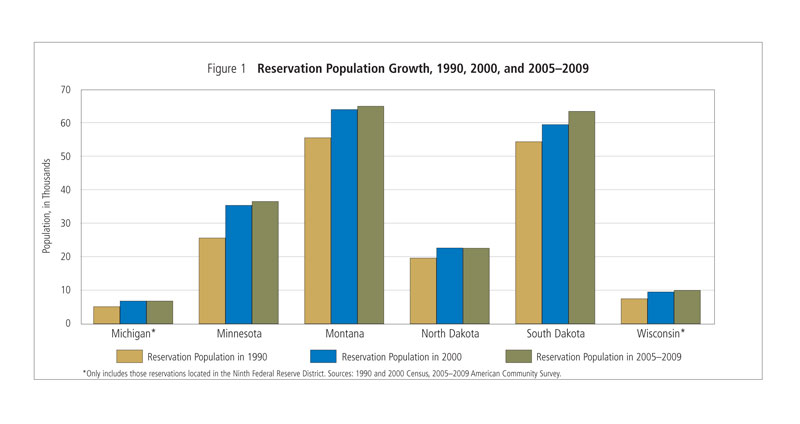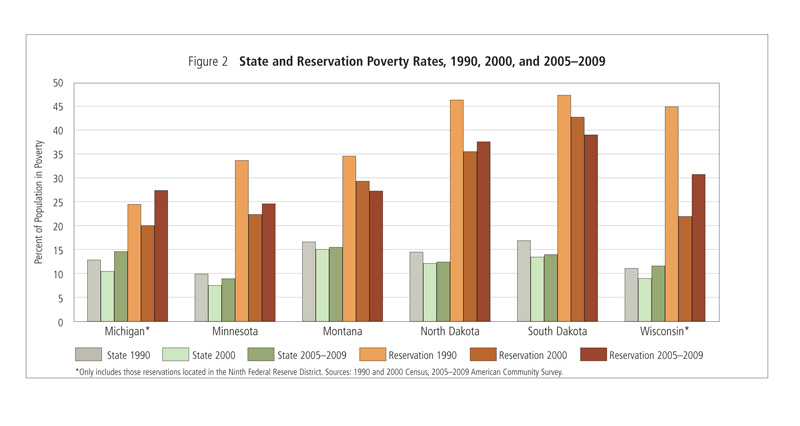|
Between 1990 and 2000, several important demographic indicators revealed broad socioeconomic improvements for the 45 American Indian reservations1/ located in the Ninth Federal Reserve District. On average, household incomes of reservation residents increased, even after adjusting for inflation, and poverty and unemployment rates declined.2/ Recently released data from the U.S. Census Bureau's American Community Survey (ACS)3/ suggest that these positive economic trends have continued on some reservations in the Ninth District. However, the data also reveal that during the recent recession and economic slowdown, poverty and unemployment rates on a number of reservations edged higher and incomes stagnated or declined. Fortunately, most reservations have held on to the gains made between 1990 and 2000, despite the recent setbacks.
The ACS data, released in early 2011, provided researchers with an opportunity to revisit demographic trends that have been recorded on reservations during decennial censuses. The data differ from decennial census data in one important way: the ACS estimates represent the average characteristics of population and housing for the period from January 2005 through December 2009 and do not represent a single point in time. The numbers used to calculate the average characteristics are from an annual survey of roughly 3 million households in the United States. The survey, which replaces the long form used in decennial censuses, provides demographic information on relatively small and lightly populated geographic areas, such as American Indian reservations, on a relatively frequent basis.
When compared to data from the previous decade of 1990–2000, the new ACS data reveal a number of notable findings. For example, between 2000 and 2005–2009, reservation populations in the states that make up the Ninth District (Minnesota, Montana, North Dakota, South Dakota, Upper Michigan, and northwestern Wisconsin) grew more slowly than during the previous decade. Between 1990 and 2000, the average annual growth rate was 1.8 percent, compared to just 0.3 percent per year after 2000. Between 2000 and 2005–2009, unemployment rates increased by an average of 2.4 percent across all reservations, while poverty rates remained largely unchanged. Whereas inflation-adjusted median household incomes rose on 9 out of every 10 reservations in 1990–2000, fewer reservations (4 out of every 10) recently posted increases in median household income. The vast majority of reservations continue to have lower incomes and higher rates of unemployment and poverty than their respective states. These unemployment- and income-related trends are discussed in greater detail below. First, we take a closer look at the findings related to population growth.
Population growth subsides
The estimate of the total number of people who live on Ninth District reservations increased by a little over 3 percent between 2000 and 2005–2009, a rate considerably lower than that of most states in the Ninth District and the nation as a whole. This muted population growth contrasts with a robust period of growth in the 1990s, when reservations added roughly 18 percent to their total population.
In aggregate, no state in the Ninth District had a net loss of reservation population during the period 2000–2005-09. However, as Figure 1 illustrates, growth rates varied among states; some had little or no growth (e.g., North Dakota) and others had modest gains (e.g., South Dakota). During the 1990s, only two Ninth District reservations, the Lake Traverse Reservation in South Dakota and the Fort Peck Reservation in Montana, had population declines. After 2000, 14 reservations experienced population declines. The less populous reservations tended to experience the greatest fluctuations in their population after 2000. For example, the population of the Sakaogon Chippewa Reservation in north central Wisconsin fell from 379 to 311, an 18 percent decline. Larger and more populous reservations experienced more modest changes in their populations, except for one prominent reservation. The Pine Ridge Reservation in South Dakota experienced a 20 percent increase in population between 2000 and 2005–2009, growing from 15,542 residents to 18,629. Since 1990, the Pine Ridge Reservation has grown by 6,500 residents (54 percent).
Click on graph to view larger image
When considering these numbers, it is important to note that not all reservation residents are American Indian, and not all American Indians live on reservations. The proportion of Ninth District reservation residents in 2005–2009 who were American Indian ranged from a low of 22 percent on the Mille Lacs Reservation in north central Minnesota to a high of 94 percent on the Rocky Boys Reservation in eastern Montana. On average, in 2005–2009, 60 percent of the population of Ninth District reservations was American Indian. In some states, the majority of the American Indian population lives off-reservation. For example, only about one-quarter of the American Indians in Minnesota live on the state's reservations. In other Ninth District states, that proportion is much higher—especially in South Dakota, where roughly two-thirds of American Indians reside on reservations.
During the earlier decade in our comparison, reservation population growth was largely fueled by American Indians. In fact, 70 percent of the increase from 1990 to 2000 was attributable to increases in the American Indian population. By contrast, American Indians accounted for only 40 percent of the more recent and modest population growth after 2000.
Economic well-being holds its own
In addition to recent, modest changes in reservation population, several indicators of economic well-being from the ACS data suggest that reservations have largely "held their own" since 2000. In fact, indicators for some reservations continue to show signs of improvement, even though they lagged behind indicators for their respective states.
Median household income
Median household incomes on reservations, after adjusting for changes in price levels over the decades, grew more slowly after 2000, due likely to the recession and economic slowdown in the broader economy. Between 2000 and 2005–2009, 40 percent of reservations in the Ninth District had rates of median income growth that were lower than the rates for their state. Similar data trends were observed for adjusted per capita income over the decade. By comparison, the share of reservations with below-state growth rates in 1990–2000 was 20 percent. Only three reservations had median household income estimates that were higher than their state estimate. They are the Lower Sioux Reservation, Prairie Island Reservation, and Shakopee Mdewakanton Sioux Reservation, all located in Minnesota within a reasonable driving distance of the Twin Cities metropolitan area. Their higher incomes may be related to the fact that all three reservations had strong casino revenue4/ during the economic downturn.
A total of 21 reservations had declines in their median household income after 2000, compared to only 5 during the previous decade. For example, the median household income on the Lac Courte Oreilles Reservation in northern Wisconsin dropped by 12 percent, from $32,135 in 2000 to $28,277 in 2005–2009. On some of the 21 reservations, it is likely that declines in casino revenue during the economic downturn contributed to the declines in median household income. While median household incomes have dropped for nearly half of the reservations since 2000, almost all of the Ninth District's reservation households still had higher median incomes in 2005–2009 than in 1990. Only three reservations had income estimates that were lower than their inflation-adjusted 1990 estimates: the Fond du Lac Reservation in Minnesota, the Minnesota Chippewa Land Trust, and the Lower Brule Reservation in South Dakota.
Unemployment
In 2005–2009, as much of the country was affected by the recession, unemployment rates for Ninth District reservations remained high compared to their respective state estimates. In 2005–2009, reservations reported a 17.4 percent unemployment rate, which was similar to the rate in 1990 (17.8 percent) and roughly 2 percent higher than the rate in 2000 (15 percent). In 2005–2009, the widest gap in unemployment rates (15.4 percentage points) occurred in South Dakota, where reservations had, on average, a 20 percent unemployment rate, compared to a rate of 4.6 percent for the state as a whole. The narrowest gap (8.6 percentage points) between reservations and the state occurred in Michigan. However, the Sault Ste. Marie Reservation in Michigan reported the highest unemployment rate among all the reservations in the Ninth District (37 percent).
Poverty
Did the economic downturn force more reservation residents into poverty? The ACS data suggest that the poverty rate for reservations in the Ninth District as a whole actually declined by 0.4 percent between 2000 and 2005–2009. Poverty rates for Montana and South Dakota reservations declined in aggregate, while rates in the other four Ninth District states edged upward from their 2000 estimates. See Figure 2.
Click on graph to view larger image
While the majority of individual reservations (40 out of 45) saw poverty rates decrease between 1990 and 2000, only about half of all reservations saw a continued decline after 2000. Some of the recent declines were dramatic, but most of these happened on less populous reservations, such as the Bois Forte Reservation in Minnesota, which saw poverty decline from 29 percent in 2000 to 13.4 percent in 2005–2009. Even with dramatic declines between 1990 and 2000, and further declines for about half of the reservations afterward, Ninth District reservations had poverty rates in 1990, 2000, and 2005–2009 that were considerably higher than their respective state averages.
There's more work to be done
Demographic indicators for American Indian reservations in the 1990s revealed important improvements in economic conditions. However, the recent recession and economic downturn, as reflected in the up-to-date reservation-level ACS data, reveal that for some reservations, these trends have since worsened or stayed the same. In particular, poverty and unemployment rates have edged higher, while incomes have stagnated or declined. Although state-level data tell roughly the same story about the impact of the recession and economic downturn, it is important to remember that sizable differences in baseline income, employment, and poverty measures still exist between reservations and their respective states. The recent ACS data strongly suggest that more work needs to be done to achieve greater economic parity for residents of Ninth District reservations.
1/ According to the U.S. Department of the Interior's Bureau of Indian Affairs, reservations are areas of land reserved for a tribe or tribes under treaty or other agreement with the U.S. government where the federal government holds title to the land in trust on behalf of the tribe(s).
2/ See Demographic trends reveal mixed portrait of Ninth District Reservations," Community Dividend, Federal Reserve Bank of Minneapolis, November 2003.
3/ ACS estimates are based on data collected over a five-year time period for geographic areas with smaller populations. For more information about the ACS, see www.census.gov.
4/ For more on casino revenue and its effects on the household incomes of reservation residents, see "Milking the new buffalo" by Doug Clement, fedgazette, Federal Reserve Bank of Minneapolis, March 2003.
Michael works to advance the economic well-being of Indian Country and low- to moderate-income individuals, households, and communities. He has conducted research and published articles on affordable housing, community development corporations, homeownership disparities, and foreclosure patterns and mitigation efforts.








